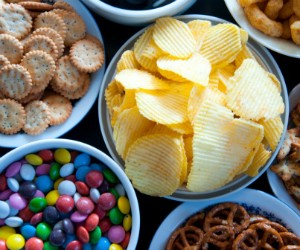Google Enlists Psychological Science to Fight Office Snack Attacks
 The way to an employee’s heart might be through their stomach as much as their wallet. One recent survey of 1,000 people found that free food at work was associated with a 20% higher likelihood of feeling extremely or very happy with their jobs.
The way to an employee’s heart might be through their stomach as much as their wallet. One recent survey of 1,000 people found that free food at work was associated with a 20% higher likelihood of feeling extremely or very happy with their jobs.
Silicon Valley tech companies have become famous for their lavish, free employee snacking options. At Google’s main campus in Mountain View, employees have access to over 30 different cafés serving breakfast, lunch, and dinner, as well as a variety of snacks. Google’s Toronto campus even has a “baconators” club where trained chefs prepare custom flavored bacon (as an example, Thai lemongrass, basil, and chili was one past flavor).
One of the problems with encouraging office snacking is that employees start to put on pounds. But taking snacks away completely—or replacing artisanal bacon products with celery and carrot sticks—might spark an employee backlash. So Google has enrolled a team of psychological scientists led by Ernest Baskin (Saint Joseph’s University) to study potential “nudges” to help employees to adopt healthier snacking habits.
“In an effort to bolster employee satisfaction, many employers provide free snacks at the office,” the researchers explain. “Snacking has become a ‘fourth meal,’ accounting for approximately a quarter of daily calories, and employees report that having free food available at work makes it difficult to keep their weight down.”
Previous research from Brian Wansink of Cornell University has demonstrated that even minor environmental cues can influence our snacking habits — “a simple step like moving a candy dish from one’s desk to a table across the room can reduce daily candy intake by more than half.” Based on these findings, Baskin and colleagues designed a field experiment to test how the layout of Google breakrooms might be subtly encouraging excessive snacking.
The researchers suspected that keeping the snacks right next to the beverage station might influence people’s consumption: As someone comes in to grab some coffee or water, they might also grab a handful of M&Ms if they’re located right next to the coffee machine.
The study was conducted in a high-traffic break room at Google’s New York office. The room contained both hot and cold beverage stations as well as a variety of free snacks including M&Ms, chocolates, nuts, cookies, granola bars, chips and pretzels, and fresh fruit. One of the beverage stations was right next to the snack bar (about 6 feet away) while the other identical beverage station was across the room (17 feet away from the snack bar).
The researchers recorded all of the beverage and snack choices made by approximately 400 employees over the course of 7 full work days. Each observation included which beverage station the employee had used, whether they’d nabbed a snack, and time of day.
As anticipated, using the beverage station right next to the snack spread increased the probability that someone would grab a snack along with their drink: Of the employees who used the beverage station near the snacks, 20% took a snack, whereas only 12% of those who used the far beverage station did.
“To put these results into perspective, for a man who drinks three beverages a day, weighs about 180 pounds and leads a mostly sedentary lifestyle at work, using the near coffee machine rather than the far one (e.g. because the near station happens to be closer to his desk) can lead him to consume an additional 81 snacks a year, which, conservatively assuming 150 calorie snacks, could result in a weight gain of about 2.5 pounds in one year,” the researchers explain.
Of course, as Baskin and colleagues note, participants were not randomly assigned to one beverage station or another. Most participants reported simply using the station that was closest to their desk.
“Although employers may be attempting to help employees by placing drinks and snacks conveniently in the same area, they may be unwittingly hurting employees by undermining their self-control and increasing their consumption of tempting snacks,” the research team concludes. “Thus, while some suggest employers can better serve employees by making it convenient to eat at the workplace, our research implies that sometimes less convenience might be more helpful.”
Reference
Baskin, E., Gorlin, M., Chance, Z., Novemsky, N., Dhar, R., Huskey, K., & Hatzis, M. (2016). Proximity of snacks to beverages increases food consumption in the workplace: A field study. Appetite, 103, 244-248. doi:10.1016/j.appet.2016.04.025





APS regularly opens certain online articles for discussion on our website. Effective February 2021, you must be a logged-in APS member to post comments. By posting a comment, you agree to our Community Guidelines and the display of your profile information, including your name and affiliation. Any opinions, findings, conclusions, or recommendations present in article comments are those of the writers and do not necessarily reflect the views of APS or the article’s author. For more information, please see our Community Guidelines.
Please login with your APS account to comment.